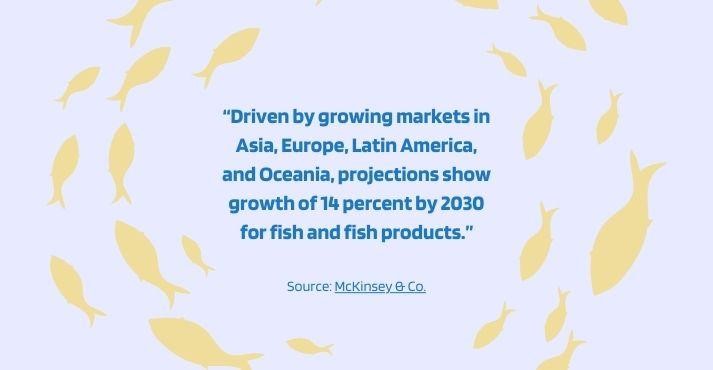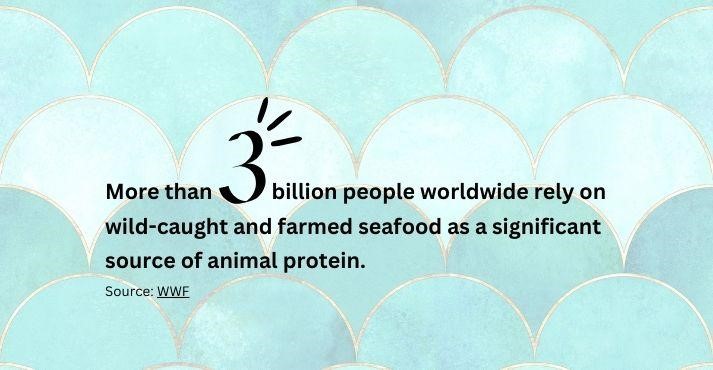The seafood industry is overgrowing and is well-positioned to scale.
The seafood industry comprises fishing, farming, and processing sectors. It can include recreational and commercial fishing activities.
Population growth, rising per capita incomes, and urbanization fuel the global seafood market. A recent survey in Singapore showed a fivefold increase in the desire to purchase seafood compared to a decade ago.
Current State of the Seafood Industry

The world’s appetite for fish and fish products shows no sign of slowing. Projections show growth of 14 percent by 2030 versus 2020 levels, driven by growing markets in Asia, Europe, Latin America, and Oceania.
According to the seafood industry statistics published by Statista, the market is projected to reach about 350 billion dollars by 2027. The average volume per person in the fish and seafood market is expected to be 4.7kg in 2023.
With the pandemic impacting everything, the seafood industry is no expectation. The impact of the pandemic has caused delays in the delivery of fresh seafood products, decreased fishing days, volume of catches, and income of fishers and aquaculture farmers.
Despite this, per the OECD projects, the seafood product is estimated to reach 203 million metric tons (Mt) by 2031, with aquaculture production accounting for 108 Mt, surpassing wild catch around 2024.5.
Seafood Market Key Players
Undoubtedly, the seafood market is vibrant, dynamic, and growing. With its diverse flavors and culinary delights, critical players in the seafood industry have captured the hearts of millions around the globe.
Some of the key market players in the industry are:
- Pacific Seafood
- Kangamiut Seafood A/S
- American Seafoods Company
- Phillips Foods, Inc.
- Trident Seafoods Corporation
- Marine Harvest ASA
- Thai Union Group PCL
- Lee Fishing Company
The influence and impact of these key players have been significant. They are under constant scrutiny to keep up with innovation, maintain quality standards, and contribute to overall sustainability.
Trends Shaping the Seafood Industry
Latest and emerging trends in Asia’s F&B industry are shaping the seafood industry.
The international fish market is increasingly moving towards new developments and adopting innovative technologies to do things better and more efficiently than we did in the past.
Let’s explore the trends shaping the seafood industry.
Sustainability Initiatives
Farmers, fishing companies, seafood processors, and traders leave an environmental footprint. Sustainability initiative is among the key trends driving the fresh food market, meeting the needs of the present without compromising the ability of future generations to meet their own needs.
Consumers and businesses increasingly prioritize responsibly sourced seafood, leading to certification, traceability efforts, and sustainable fishing practices gaining prominence.
For example, combining aquaculture with hydroponics will create a closed-loop system where fish waste fertilizes plants, and plants purify water, conserving resources and reducing pollution.
Sustainability initiatives such as implementing catch limits, size restrictions, and seasonal closures ensure fish stocks remain healthy and abundant, reducing overfishing and protecting marine ecosystems.
Technology Advancements
Technological advancements and innovations are another key trends shaping the seafood industry.
The role of technology in seafood has evolved over the last decade in response to factors such as reducing waste, increasing shelf-life, efficient food warehousing, use of blockchain technology, and innovative production processes.
IoT in aquaculture, like sensors and cameras, enables real-time water quality, feeding, and fish health monitoring. It can be used to optimize fishing operations, reduce waste, and enhance overall sustainability by preventing issues and promoting efficient resource use.
Blockchain technology ensures transparency in the seafood supply chain. It can help maintain records from catch to consumption, making traceability easier. It will result in less fraud, illegal fishing, and overfishing.
Moreover, seafood generates a lot of data but needs more data digitalization.
Therefore, the industry must invest in data gathering and analysis. For example, as a seafood exporter, you can better understand your business, track historical records, analyze patterns, and conduct predictive production analyses.
And even for food importers, digitalized data will help them monitor quality, volume, and price development to make strategic decisions.
Changing Consumer Preferences
The dynamic nature of demand in the global fish market is driven by changing consumer preferences. If we examine the most preferred seafood among consumers globally, by value, salmon is the largest single fish commodity in the world, and by volume or weight, it is tuna.
The Salmon market size is expected to grow from USD 31.00 billion in 2023 to USD 45.70 billion by 2028, at a CAGR of 8.07% during the forecast period (2023-2028). Due to its health benefits, as it contains high protein and omega-3 fatty acids.
According to GMI, the market size of canned tuna is estimated to grow at over 4.5% CAGR from 2023 to 2032. It is a practical choice for consumers seeking convenience, as it has a longer shelf life and a quick source of protein.
In this digital age, consumers are more curious and informed. As more people turn to seafood, they look for eco-labels, responsibly sourced products, halal food, ready-to-eat, and convenience meal options.
According to MSC’s most extensive global seafood consumer perceptions study, 71% of consumers believe that sustainability claims must be clearly labeled, 56% are willing to pay more for seafood from certified suppliers, and 65% state a need to protect the ocean and limit consumption.
Moreover, a critical step towards accelerating the seafood business is to adopt food safety practices to prevent biological hazards and ensure the best quality reaches the consumers.
Challenges and Concerns

The seafood industry faces severe challenges, as with other parts of the food sector. Global demand is increasing, but barriers to scaling seafood production remain a frontier to be addressed.
As the world’s population is growing, more fish and other aquatic species will be needed than ever before. With significant changes underway, economic, food, and climate change will likely impact the seafood industry.
Moving forward, it will be necessary for the seafood stakeholders to consider the following challenges and concerns:
- Climate change is likely to exacerbate due to CO2 emissions, changes in ocean properties, rising sea temperatures, and acidity levels scaling at an unprecedented rate.
- Global marine ecosystems and fisheries are further expected to pressure the international community to focus on sustainable goals.
- Overfishing leads to declining fish populations, impacting marine ecosystems and the seafood industry’s long-term sustainability. It also causes collateral damage to non-target species and disrupts the balance of underwater ecosystems.
- Marine pollution from shipping, aquaculture, and coastal development poses significant environmental challenges to the seafood industry. Contaminants can harm seafood quality and marine life, impacting the industry’s reputation.
- The overarching international framework for certification and eco-label monitoring is essential. The need for standardization in the industry creates complex and critical issues.
Future of the Seafood Industry

According to WWF, more than 3 billion people worldwide rely on wild-caught and farmed seafood as a significant source of animal protein. In the face of the challenges and concerns, the seafood industry also has windows of opportunities open for businesses.
The international seafood market has strengthened its position with high-quality seafood that is value for money. With greater enhanced consistency in supply chains and traceability, greater consumer trust will be developed using blockchain methods.
Sustainable practices and responsible management will likely play a central role as overfishing and environmental concerns threaten global fisheries. Aquaculture will grow in importance, providing an increasing share of seafood production.
Efforts by the food manufacturers in the seafood industry must be made to foreground the great taste of seafood to consumers, addressing the health-related aspects and increasing consumer consciousness towards quality and eco-labeling.
Also, consumer demand for sustainably sourced seafood will drive industry shifts.
According to The World Bank, 62% of food fish will come from aquaculture by 2030, with the fastest supply growth likely to come from tilapia, carp, and catfish. Asia – including South Asia, South-East Asia, China, and Japan – is projected to make up 70 percent of global fish consumption by 2030.
The Agricultural Outlook 2021-2030 published by OECD-FAO, by 2030, it is projected that 90% of fish production will be consumed as food, 8% reduced into fishmeal and fish oil, and the remaining 2% as other non-food uses.
Frequently Asked Questions (FAQs)
What is the major restraint of the seafood industry?
The major restraint of the seafood industry is overfishing. Overfishing occurs when the rate of fishing exceeds the natural reproduction and growth rates of fish stocks, leading to declining populations and potential ecosystem disruptions.
It threatens the sustainability of seafood resources and impacts the long-term economic viability of the industry.
What is the critical factor driving the seafood market?
The key factors driving the seafood market are:
- Increasing global population
- Rising consumer awareness of health benefits
- Expansion of aquaculture
- Growing demand for sustainable seafood
- Advancements in seafood processing and distribution
Which is the leading product segment in the seafood market?
Fish and fish products are primarily the leading product segment in the seafood market. It includes fresh seafood such as salmon, tuna, and cod and processed fish products such as fish fillets, fish oil, and canned fish.
Closing Thoughts
The seafood industry is poised to grow as consumers worldwide demand seafood products and delicacies. Despite the increasing prominence, the industry impacts economies and diets worldwide, from bustling fish markets in coastal villages to high-tech aquaculture farms.
As the seafood industry expands, several challenges must be addressed through transformation with more efficient, inclusive, resilient, and sustainable solutions that reduce the negative impact. Moreover, seafood manufacturers must focus on creating supply chains that reduce food loss and waste.
Significant policy changes will positively impact the seafood market, driving the growth in food fish consumption.
Rising urbanization, expansion of fish production, improved distribution channels, product innovation, lower prices, and a growing recognition of fish as healthy and nutritious food by consumers are further expected to grow in the next decade.
The symbiotic relationship between the seafood industry and the world fish market underscores the need for thoughtful, long-term strategies.













